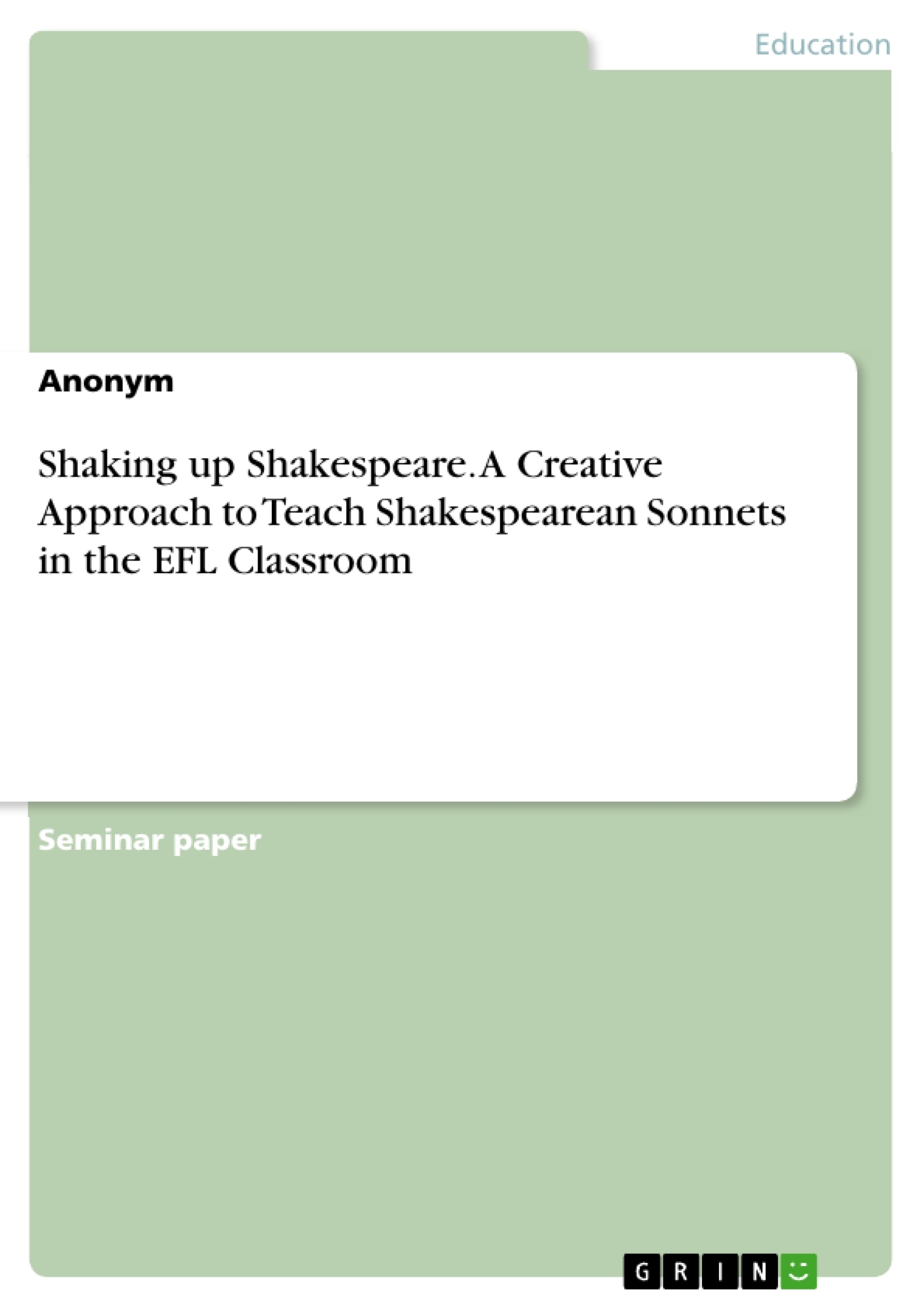In North Rhine-Westphalia teaching Shakespeare is, as in other federal states, an integral part in the curriculum for the Sekundarstufe II in English and has equal to the prior years, in the upcoming Abitur 2021 Shakespeare in its standards. However, in recent years the acceptance of Shakespeare in the classroom was highly discussed. In a survey, hold by Isolde Schmidt in 2004, more than hundred students, attending an English Leistungskurs, were asked about their acceptance with Shakespeare. Surprisingly, a large number of students expressed a positive association with Shakespeare, emphasizing the great importance of the author for the international cultural heritage. However, a lot of students were dissatisfied with the applied pedagogical teaching approach.
Based on this decline of motivation related to the applied pedagogical teaching approach, the teaching of Shakespearean sonnets is complicated by the fact that the teaching of the genre poetry brings along its own challenges for the classroom. The resentment to poetry has also risen from the “one-sided teaching approach” in which the main focus is set on the “formalistic and analytic interpretation” gearing towards finding the right meaning. To prevent the total loss of motivation and interest of the students the focus of teaching should be shifted to creative approaches. With the implementation of innovative student-centred, process- and task-based methods using different media and referring to the environments of the students, traditional teacher-centred methods can be superseded and thus students’ motivation can be awakened and maintained.
In order to show that the teaching of Shakespearean sonnets has not only to be limited to formalistic and analytic interpretations, this paper will demonstrate creative methods for teaching Shakespearean sonnets. The paper is divided into two parts. The first part deals with the theoretical background on teaching sonnets. Since sonnets belong to the genre of poetry, I will first outline the role and benefits of teaching poetry. Afterwards, I will address the potential and challenges of teaching Shakespeare. [...]
Table of Contents
- Introduction: Shaking up Shakespeare
- Theoretical Background: Creative Approaches to Teaching Shakespearean Sonnets in the EFL Classroom
- The Role and Benefits of Teaching Poetry
- To Teach or Not to Teach? - Potential and Challenges of Teaching Shakespeare in the EFL Classroom
- Creative Approaches to Teaching Shakespearean Sonnets
- Sonnet 116 by William Shakespeare
- Critical Analysis of the Teaching Unit to Sonnet 116 in Green Line Oberstufe
- Critical Analysis of the Teaching Approach to Sonnet 116 in Green Line Oberstufe
- Application: An Alternative Creative Lesson on Sonnet 116
- Conclusion
Objectives and Key Themes
This paper aims to showcase innovative and creative methods for teaching Shakespearean sonnets in an EFL classroom. It emphasizes the need to shift away from traditional, formalistic interpretations and explore student-centered, process-based, and task-based approaches. The paper explores the challenges and benefits of teaching poetry and Shakespeare in the EFL classroom, highlighting the importance of engaging students' interests and fostering their creativity.
- The challenges and benefits of teaching poetry in the EFL classroom.
- The importance of creative and student-centered approaches to teaching Shakespeare.
- The potential and challenges of teaching Shakespeare in the EFL classroom.
- An analysis of a teaching unit for Sonnet 116 and the development of an alternative creative lesson.
- The need to overcome the resentment towards poetry and its "one-sided teaching approach."
Chapter Summaries
The introduction highlights the importance of teaching Shakespeare in the German curriculum, but acknowledges the declining student motivation due to traditional teaching methods. It sets the stage for exploring creative approaches to teaching Shakespearean sonnets.
The theoretical background chapter delves into the role and benefits of teaching poetry in the EFL classroom, highlighting the potential challenges and the need for innovative approaches. It discusses the importance of engaging students emotionally and fostering their creativity.
The chapter on Sonnet 116 provides a critical analysis of a teaching unit from the textbook Green Line Oberstufe, examining its strengths and weaknesses in terms of creativity. This analysis lays the foundation for the development of an alternative, more creative lesson.
Keywords
The paper focuses on teaching Shakespearean sonnets in the EFL classroom, employing creative and student-centered methods to enhance engagement and overcome the challenges of teaching poetry and Shakespeare. Key topics include creative teaching approaches, EFL pedagogy, Shakespeare, Sonnets, poetry analysis, and student motivation.
- Citation du texte
- Anonym (Auteur), 2020, Shaking up Shakespeare. A Creative Approach to Teach Shakespearean Sonnets in the EFL Classroom, Munich, GRIN Verlag, https://www.grin.com/document/1170278



